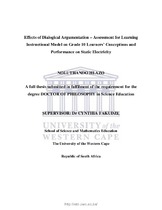| dc.contributor.advisor | Fakudze, Cynthia | |
| dc.contributor.author | Hlazo, Noluthando | |
| dc.date.accessioned | 2022-03-09T09:34:56Z | |
| dc.date.available | 2022-03-09T09:34:56Z | |
| dc.date.issued | 2021 | |
| dc.identifier.uri | http://hdl.handle.net/11394/8861 | |
| dc.description | Philosophiae Doctor - PhD | en_US |
| dc.description.abstract | This study examined the effects of using Dialogical Argumentation and Assessment for Learning
as an Instructional Method (DAAFLIM) in teaching static electricity focussing on lightning as an
example of static electricity to Grade 10 learners. Three groups of learners from two township
schools were used as a sample for the study. The Solomon three-group design was employed in
collecting data. One class was used as the experimental group and the other two were the control
groups: control 1 group and control 2 group.
The study drew on theoretical frameworks associated with prior knowledge of learners such as the
constructivist viewpoint. The frameworks that were applied in the analysis of the data were
Toulmin’s Argumentation Pattern (TAP) and Ogunniyi’s Contiguity Argumentation Theory
(CAT). The experimental group and control group 2 were exposed to DAAFLIM as a teaching
method and AFL as the assessment strategy. The control 1 group was taught in the traditional
chalk- talk method and assessment was mostly summative. The experimental and control 1 groups
received pre-tests and also wrote a post-test whereas the control 2 group only wrote the post test. | en_US |
| dc.language.iso | en | en_US |
| dc.publisher | University of the Western Cape | en_US |
| dc.subject | Learning | en_US |
| dc.subject | Dialogical Argumentation and Assessment | en_US |
| dc.subject | Static electricity | en_US |
| dc.subject | Grade 10 learners | en_US |
| dc.title | Effects of Dialogical Argumentation – Assessment for Learning Instructional Model on Grade 10 Learners’ Conceptions and Performance on Static Electricity | en_US |
| dc.rights.holder | University of the Western Cape | en_US |

